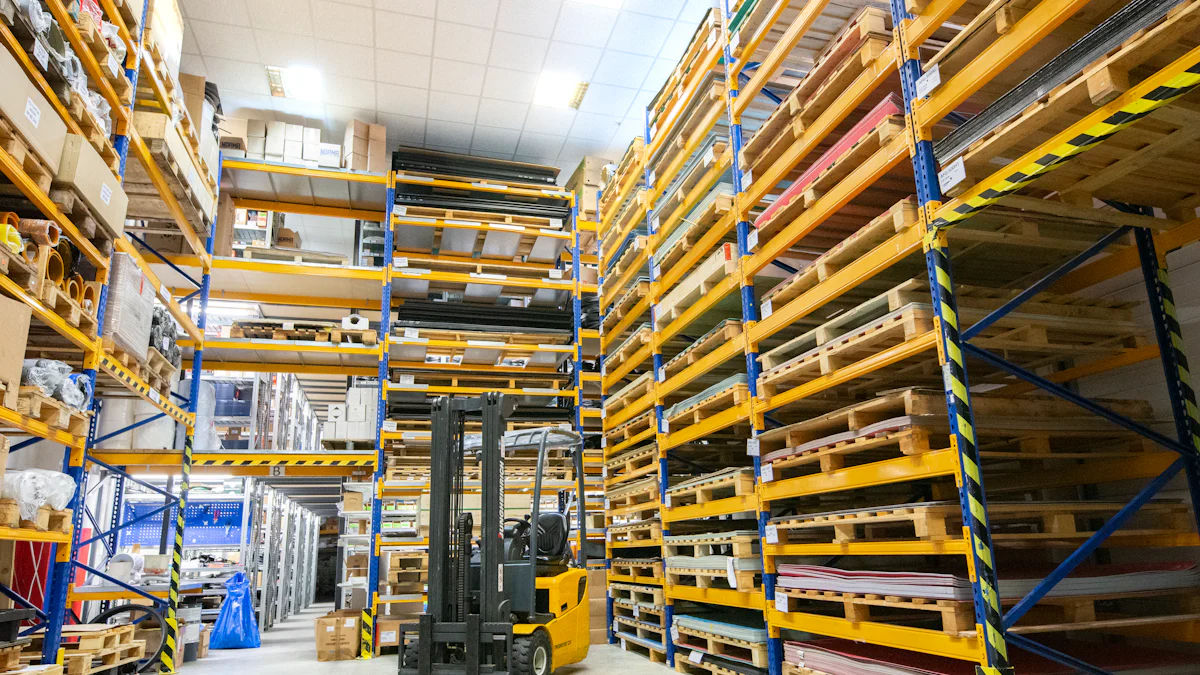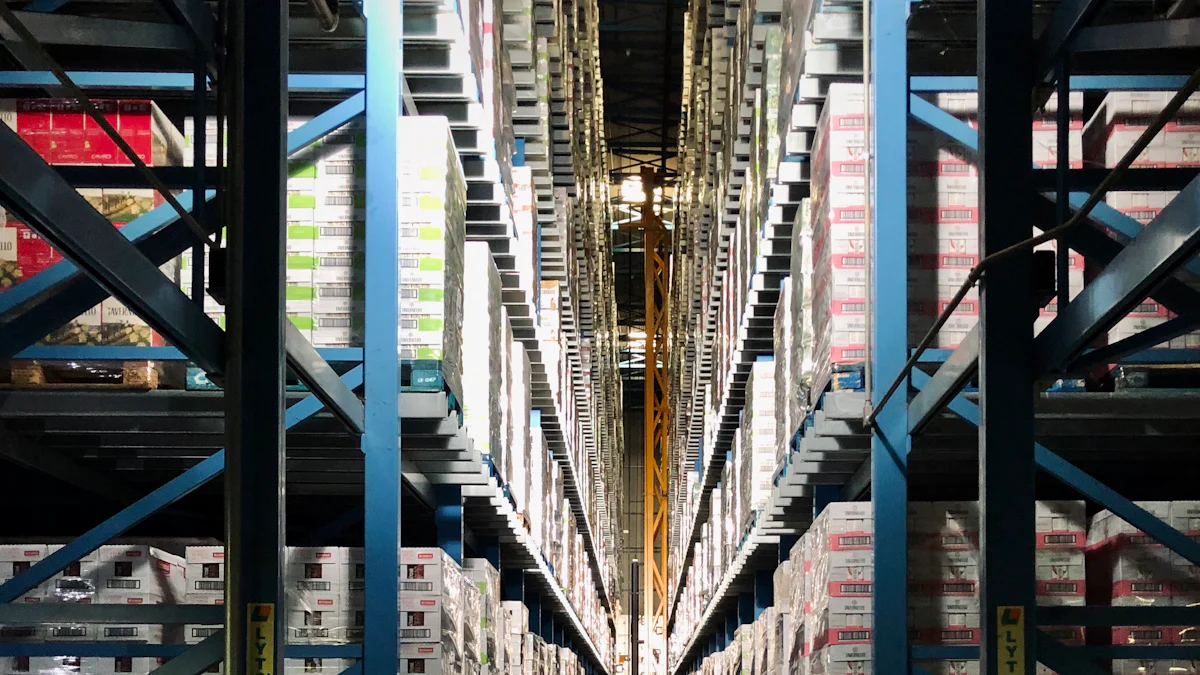Understanding Warehouse Automation: Benefits and Best Practices

Warehouse automation involves deploying technology to streamline and optimize warehouse operations. Automation has emerged as the solution to address pressing supply chain issues such as labor challenges, fulfillment quality, safety, space utilization, and throughput. The warehouse automation market has experienced significant growth, with projections estimating it will reach $37.6 billion by 2030. Automation technologies enhance efficiency, accuracy, and productivity, leading to reduced costs and improved performance. Businesses can create more secure, productive, and profitable environments through effective automation.
Create Site Now
Get a High-Converting Landing Page in Just One Minute
What is Warehouse Automation?
Definition and Explanation
Warehouse automation involves using technology to perform tasks within a warehouse that humans traditionally handle. Automation aims to streamline operations, improve efficiency, and reduce errors. Automated systems can handle various functions such as inventory management, order picking, packing, and sorting.
Key Components of Warehouse Automation
Several key components form the backbone of warehouse automation:
Automated Storage and Retrieval Systems (AS/RS): These systems store and retrieve products with minimal human intervention. AS/RS includes cranes, shuttles, and carousels.
Conveyor Systems: Conveyors transport goods throughout the warehouse, reducing manual handling.
Robotic Picking Systems: Robots equipped with sensors and cameras pick items from shelves and place them in bins or on conveyors.
Warehouse Management Systems (WMS): Software that manages inventory, tracks orders, and optimizes warehouse operations.
Automated Guided Vehicles (AGVs): Vehicles that navigate the warehouse floor to transport goods without human drivers.
Types of Warehouse Automation Technologies
Warehouse automation technologies vary in complexity and application:
Basic Automation: Includes conveyor belts and basic mechanized equipment.
Advanced Automation: Involves more sophisticated systems like AS/RS and robotic picking.
Autonomous Mobile Robots (AMRs): Robots that move independently within the warehouse to assist with various tasks.
Artificial Intelligence (AI) and Machine Learning (ML): Technologies that enhance decision-making and predictive analytics in warehouse operations.
Historical Context
Evolution of Warehouse Automation
The evolution of warehouse automation began with the development of the first Automated Storage and Retrieval System (AS/RS). This innovation laid the foundation for modern Warehouse Management Systems (WMS). Over time, advancements in robotics, software, and artificial intelligence have transformed warehouse operations.
Key Milestones in Warehouse Automation
Several key milestones mark the progress of warehouse automation:
1960s: Introduction of the first AS/RS, revolutionizing storage and retrieval processes.
1970s: Development of the first real-time Warehouse Management Software, changing supply chain management.
1980s: Emergence of conveyor systems and basic mechanization.
1990s: Advancements in robotic technology and the introduction of AGVs.
2000s: Integration of AI and ML into warehouse operations, enhancing efficiency and accuracy.
2010s: Widespread adoption of AMRs and advanced automation solutions.
Benefits of Warehouse Automation

Operational Efficiency
Increased Productivity
Warehouse automation significantly boosts productivity. Automated systems handle repetitive tasks faster than humans. For example, robotic picking systems can operate continuously without breaks. This efficiency leads to an increase in labor productivity by up to 85%. Automated Guided Vehicles (AGVs) and Autonomous Mobile Robots (AMRs) transport goods swiftly across the warehouse, reducing downtime. Businesses can fulfill more orders in less time, enhancing overall throughput.
Reduced Errors
Automation minimizes human errors. Automated systems ensure precise execution of tasks like order picking and inventory management. Errors in manual processes often lead to costly mistakes. For instance, incorrect order fulfillment can result in customer dissatisfaction. Automated systems use sensors and cameras to verify each step, ensuring accuracy. This leads to a significant reduction in error rates, improving the reliability of warehouse operations.
Cost Savings
Labor Cost Reduction
Warehouse automation reduces labor costs. Automated systems perform tasks that would otherwise require human labor. This decreases the need for a large workforce. Businesses save on wages, benefits, and training expenses. Automated systems also work around the clock, eliminating the need for overtime pay. These savings contribute to a more cost-effective operation.
Inventory Management
Effective inventory management is another benefit of warehouse automation. Automated systems track inventory levels in real-time. This reduces the risk of overstocking or stockouts. Accurate inventory data helps businesses make informed decisions. Automated storage and retrieval systems (AS/RS) optimize space utilization, reducing storage costs. This leads to better inventory control and cost savings.
Enhanced Accuracy and Reliability
Improved Order Fulfillment
Warehouse automation enhances order fulfillment accuracy. Automated systems ensure that the correct items are picked and packed. This reduces the likelihood of shipping errors. Customers receive the right products on time, leading to higher satisfaction. Improved order accuracy also reduces return rates, saving businesses money.
Real-time Data and Analytics
Automation provides real-time data and analytics. Warehouse Management Systems (WMS) monitor operations continuously. This data helps identify inefficiencies and areas for improvement. Businesses can make data-driven decisions to optimize processes. Real-time analytics also enable proactive maintenance, reducing downtime. This ensures a reliable and efficient warehouse operation.
Best Practices for Implementing Warehouse Automation
Planning and Strategy
Assessing Needs and Goals
Effective planning begins with a thorough assessment of the warehouse's needs and goals. Identify specific pain points in current operations. Determine which tasks will benefit most from automation. Consider factors such as order volume, inventory turnover, and labor costs. Establish clear objectives for implementing warehouse automation. These objectives may include increasing productivity, reducing errors, or improving order fulfillment accuracy.
Budgeting and ROI Analysis
Budgeting plays a crucial role in the successful implementation of warehouse automation. Calculate the total cost of ownership, including initial investment, maintenance, and potential downtime. Conduct a Return on Investment (ROI) analysis to understand the financial benefits. Compare the costs saved through reduced labor and increased efficiency against the investment. A positive ROI indicates a worthwhile investment. Ensure the budget aligns with the company's financial capabilities.
Technology Selection
Evaluating Automation Solutions
Selecting the right technology requires careful evaluation of available solutions. Research various warehouse automation technologies and their capabilities. Consider the specific needs identified during the planning phase. Look for solutions that offer scalability and flexibility. Evaluate the reliability and performance of different systems. Seek feedback from other businesses that have implemented similar technologies. Make an informed decision based on comprehensive research and analysis.
Integration with Existing Systems
Integration with existing systems is essential for seamless operations. Ensure the chosen automation technology can integrate with the current Warehouse Management System (WMS). Compatibility reduces disruptions and enhances overall efficiency. Plan for potential challenges during the integration process. Work closely with technology providers to address any issues. Successful integration ensures a smooth transition to automated operations.
Implementation and Training
Pilot Testing
Pilot testing is a critical step before full-scale implementation. Conduct a pilot test in a controlled environment within the warehouse. Monitor the performance of the automated system. Identify any issues or areas for improvement. Use the insights gained from the pilot test to refine the system. Pilot testing minimizes risks and ensures the system functions as expected.
Employee Training and Change Management
Employee training is vital for the successful adoption of warehouse automation. Provide comprehensive training programs for all staff members. Ensure employees understand how to operate and maintain the new systems. Address any concerns or resistance to change. Effective change management strategies help employees adapt to new processes. A well-trained workforce maximizes the benefits of warehouse automation.
Monitoring and Optimization
Continuous Improvement
Continuous improvement plays a crucial role in maintaining the efficiency of warehouse automation. Businesses must regularly review and refine automated systems to ensure optimal performance. Regular audits help identify areas that need enhancement. Implementing feedback loops allows for ongoing adjustments based on real-time data. This approach ensures that warehouse operations remain efficient and effective.
Adopting a proactive mindset towards continuous improvement can lead to significant gains. For instance, businesses can leverage predictive analytics to foresee potential issues before they arise. This foresight enables preemptive measures, reducing downtime and maintaining smooth operations. Continuous improvement fosters a culture of innovation, driving long-term success in warehouse automation.
Performance Metrics and KPIs
Measuring performance metrics and Key Performance Indicators (KPIs) is essential for monitoring warehouse automation. These metrics provide valuable insights into the effectiveness of automated systems. Common KPIs include order accuracy, inventory turnover, and throughput rates. Tracking these indicators helps businesses gauge the success of their automation efforts.
Order accuracy measures the precision of order fulfillment processes. High order accuracy indicates reliable automation systems. Inventory turnover assesses how quickly inventory moves through the warehouse. A high turnover rate signifies efficient inventory management. Throughput rates measure the volume of goods processed within a specific timeframe. Higher throughput rates reflect increased productivity.
Businesses should also monitor system uptime and downtime. Uptime measures the availability of automated systems, while downtime tracks periods of inactivity. Minimizing downtime is critical for maintaining operational efficiency. Regular maintenance and timely updates contribute to higher system uptime.
Incorporating real-time data analytics enhances the monitoring process. Advanced analytics tools provide actionable insights, enabling data-driven decision-making. Real-time data allows for immediate adjustments, ensuring continuous optimization of warehouse operations. Effective monitoring and optimization lead to more secure, productive, and profitable environments.
Case Studies and Examples

Successful Implementations
Standard-Robots
Standard-Robots has implemented warehouse automation to enhance operational efficiency. The company deployed Automated Guided Vehicles (AGVs) to transport goods across the warehouse. AGVs reduced manual labor and increased throughput by 85%. The use of robotic picking systems minimized errors in order fulfillment. Standard-Robots also integrated a Warehouse Management System (WMS) to track inventory in real-time. This integration improved inventory accuracy and reduced stockouts. The overall productivity of the warehouse saw a significant boost.
HAI Robotics
HAI Robotics utilized warehouse automation to optimize space utilization and improve worker productivity. The company introduced Autonomous Mobile Robots (AMRs) to handle repetitive tasks. AMRs navigated the warehouse independently, transporting items efficiently. HAI Robotics also implemented Automated Storage and Retrieval Systems (AS/RS) to maximize storage capacity. The automation technologies reduced labor costs and enhanced order fulfillment accuracy. Workers experienced increased job satisfaction due to the reduction in manual tasks.
Lessons Learned
Common Challenges
Implementing warehouse automation presents several challenges. One common challenge involves the initial cost of automation technologies. Businesses must invest significantly in equipment and software. Another challenge is the integration of new systems with existing infrastructure. Compatibility issues can disrupt operations. Training employees to operate automated systems also poses a challenge. Workers may resist changes, leading to delays in adoption.
Overcoming Obstacles
Businesses can overcome these challenges through strategic planning. Conducting a thorough assessment of needs helps identify the most suitable automation solutions. Pilot testing allows businesses to evaluate the performance of automated systems before full-scale implementation. Providing comprehensive training programs ensures employees understand how to use new technologies. Effective change management strategies address resistance and facilitate smooth transitions. Continuous improvement practices help refine automated systems for optimal performance.
Warehouse automation has revolutionized warehouse operations. Businesses have experienced increased productivity, reduced errors, and significant cost savings. Automation technologies like Automated Guided Vehicles (AGVs) and Autonomous Mobile Robots (AMRs) have enhanced efficiency and accuracy.
The future of warehouse automation looks promising. Innovations will continue to drive improvements in operational efficiency and performance. Companies will benefit from adopting these advanced technologies.
Businesses should consider implementing warehouse automation. The potential for increased productivity and cost savings is substantial. Investing in automation can create more secure, productive, and profitable environments.
See Also
Essential AGV Tech Updates You Should Be Aware Of
Understanding Email Automation and Its Operations
Best Power Banks of 2024: Our Top Choices